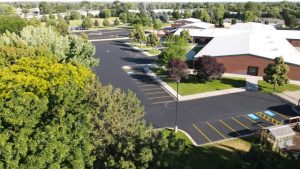Ideal Weather and Seasonal Conditions for Asphalt Maintenance Projects
Asphalt maintenance is an essential task to prolong the lifespan and appearance of your pavement, but timing plays a crucial role in how effective that maintenance will be. The weather and seasonal conditions can directly impact the success of various asphalt maintenance projects, such as sealcoating, crack filling, or resurfacing. Understanding the ideal conditions for asphalt maintenance helps ensure that your pavement gets the care it needs and lasts longer without premature cracking or wear.
1. Why Weather Conditions Matter in Asphalt Maintenance
Asphalt maintenance projects rely on certain conditions to allow materials like asphalt mixes, sealants, and crack fillers to bond properly to the surface. Weather factors such as temperature, humidity, and precipitation can all affect the outcome of these projects.
- Temperature: Both the air and ground temperatures need to be warm enough for asphalt products to cure properly. If it’s too cold, the materials won’t bond correctly, leading to cracks, peeling, or rapid deterioration.
- Humidity: High humidity levels can delay the drying process, especially for sealcoating projects. Sealants need to dry thoroughly to form a protective layer, and too much moisture in the air can slow this process.
- Precipitation: Rain is one of the biggest enemies of asphalt maintenance projects. If rain falls before the materials have had time to dry or cure, it can wash them away or prevent them from adhering properly.
For these reasons, choosing the right season and monitoring the weather forecast is essential for successful asphalt maintenance.
2. Spring: A Good Time for Crack Filling and Repairs
Spring is often one of the best times forcrack filling and smaller asphalt repairs. As the weather begins to warm up after the winter, asphalt surfaces may develop cracks due to the freeze-thaw cycle. Repairing these cracks in the spring helps prevent them from expanding and causing further damage.
- Temperature: In most regions, temperatures in spring range between 50°F and 70°F, which is ideal for crack filling. Crack sealants bond best when the ground is neither too hot nor too cold.
- Humidity: Spring can bring rain, so it’s important to watch the forecast before scheduling any asphalt work. Make sure there are a few dry days to allow the crack filler to set without interference from moisture.
- Traffic: Traffic is typically lighter in the spring, which can be a good time to schedule repairs without significant disruption.
Spring is an optimal time for patching potholes as well, especially those that developed during the colder months. Repairing potholes early prevents them from growing larger and causing extensive damage to the pavement’s structure.
3. Summer: The Prime Season for Sealcoating and Resurfacing
Summer is often considered the best time of year for major asphalt maintenance projects like sealcoating and resurfacing. Warmer temperatures provide the perfect environment for asphalt materials to bond and cure effectively.
- Ideal Temperatures: For sealcoating and resurfacing, temperatures between 70°F and 90°F are ideal. Hotter weather helps sealants dry faster and creates optimal conditions for resurfacing projects, where asphalt needs to cure and harden.
- Low Humidity: Summer typically brings low humidity in many regions, which is great for projects like sealcoating. Humidity that is too high can slow down the drying process, but warm, dry summer air allows the sealcoat to cure more quickly and thoroughly.
- Longer Days: Summer’s longer daylight hours allow for more work to be completed in a single day, making it an ideal season for large-scale asphalt projects that require multiple applications or extensive resurfacing.
One of the main advantages of sealcoating in the summer is that it creates a strong, durable protective layer before the cold weather sets in. This barrier prevents damage from water, chemicals, and UV rays, helping your asphalt surface withstand the harsh conditions of the fall and winter.
4. Fall: The Last Call for Major Asphalt Projects
Fall is another excellent season for asphalt maintenance, particularly in areas where temperatures remain mild through October or November. Many property owners take advantage of the fall season to complete any remaining repairs or sealcoating before winter sets in.
- Mild Temperatures: Early fall often brings mild temperatures similar to those in the spring, which are ideal for asphalt maintenance. Temperatures between 50°F and 80°F are perfect for crack sealing and applying a protective sealcoat.
- Less Rain: While rain can still occur in the fall, it’s usually less frequent than in spring. This makes it a good season for completing asphalt projects without worrying as much about precipitation delays.
- Pre-Winter Protection: Completing asphalt maintenance in the fall is essential for preparing your surface for the harsh conditions of winter. Sealing cracks and applying a sealcoat before freezing temperatures arrive prevents water from seeping into the pavement, which can cause cracks to expand and damage the surface during freeze-thaw cycles.
Keep in mind that as temperatures drop later in the season, it becomes harder to complete asphalt projects. Once temperatures fall below 50°F, it’s no longer ideal for sealcoating, crack filling, or resurfacing.
5. Winter: Limited Asphalt Maintenance Opportunities
Winter is typically not suitable for most asphalt maintenance projects due to cold temperatures, snow, and ice. Asphalt materials and sealants don’t bond properly in freezing conditions, making it challenging to complete effective repairs.
- Cold Temperatures: When temperatures dip below 50°F, asphalt materials can become too stiff to spread and bond properly. Sealcoating and resurfacing should be avoided in the winter months.
- Precipitation: Snow and ice are frequent in winter, making it impossible to perform asphalt work. Even minor repairs like crack filling can be difficult, as the surface needs to be dry and free of ice or snow for the materials to adhere properly.
That said, if you’re in a region with mild winters or if there are a few warm days during the season, it might be possible to complete emergency repairs. However, most asphalt maintenance should be postponed until spring when conditions improve.
6. Planning Ahead: How to Schedule Asphalt Maintenance
The key to successful asphalt maintenance is planning ahead. Weather can be unpredictable, so it’s important to keep a close eye on the forecast and choose the best time of year for your specific project.
- Book Early: Asphalt contractors tend to get busy during the warmer months, especially in spring and summer. Booking your project early ensures you get a spot on their schedule during the ideal weather window.
- Be Flexible: Even if you schedule your maintenance for the right season, weather conditions can change unexpectedly. Be prepared to reschedule if rain or extreme temperatures are in the forecast to ensure the best outcome for your project.


